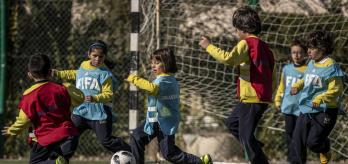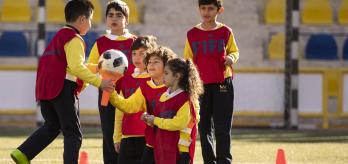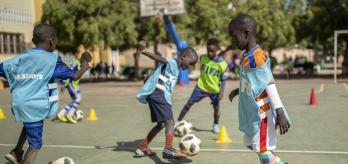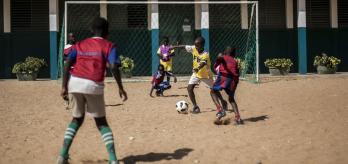In this edition of FIFA’s Grassroots Coaching Essentials series, Dr Vanessa Martinez Lagunas explains how to optimise warm-ups for players aged 12 to 15. This article provides three key insights into making warm-ups effective: creating an age-appropriate setup, incorporating dynamic activation, and ensuring a seamless transition into the main training theme through an effective session structure.
Throughout this article, you will find practical examples of warm-up exercises focused on passing, feinting and dribbling, and shooting. These examples are designed to help coaches prepare young players both physically and technically, ensuring they are fully engaged and ready for training.
Below, you will see a video presentation in which Vanessa expands on these key tips. This is followed by a written summary and diagrams of the activities, offering coaches a comprehensive resource to enhance their training sessions.
Tip 1: Use age-specific warm-ups
Integrating age-specific warm-ups ensures that players are physically prepared for training while reinforcing key football skills. In this section, Vanessa highlights the importance of a structured warm-up at the start of a session and how coaches can maximise its effectiveness:
- Gradually increase intensity: Start with a general warm-up, then move on to a more focused technical session to ensure players are physically and technically prepared.
- Keep it simple: Concentrate on a handful of key coaching points. Avoid excessive over-coaching, as too many instructions and details can disrupt the flow and effectiveness of the warm-up.
- Add competition: Incorporate a competitive edge to make the activity more engaging, elevate intensity, and fully prepare players for the main session.
Tip 2: Consider warm-up structure
A well-structured warm-up not only prepares players for the demands of the session but also enhances their technical skills. Here, Vanessa outlines how to optimise warm-ups for better player progression:
- Begin with general activation: To minimise the risk of injury, begin with a general activation phase in which players carry out basic warm-up exercises to ready their bodies for the upcoming activities.
- Tag games for activation: Incorporating tag games before a dribbling session is a great way to keep players engaged while emphasising agility and quick changes of direction.
- Adapt for different skill levels: To ensure all players stay engaged and challenged, coaches can modify the playing area or rules and adjust the number of balls used.
Tip 3: Think about session structure
A well-structured session is essential for maximising player development. Vanessa highlights how aligning the warm-up with the session’s theme reinforces learning, maintains consistency in practice, and fosters a more effective training environment:
- Integrating shooting exercises: Shooting can be incorporated into the warm-up, but it is important to start with a gradual increase in intensity through general movement to ensure players are properly prepared and reduce the risk of injury.
- Enhancing effectiveness: Try to maintain a consistent setup and organisation for both the general and specific warm-ups, as this will help maximise practice time and ensure a smoother transition between the two.
- Consider goalkeepers' needs: Make sure that all players, including goalkeepers, warm up properly by gradually increasing the intensity so they are fully prepared for the session.
Key Take-aways
Based on the key insights shared by Vanessa in this presentation, coaches should now have a clearer understanding of how to design and optimise warm-ups that prepare players aged 12 to 15 effectively while supporting their technical development. Here is a summary of the essential takeaways from this presentation:
- Age-specific warm-ups: As players get older, it becomes increasingly important to gradually raise the intensity of the warm-up to prevent injuries and ensure they are adequately prepared.
- Warm-up structure: Effective warm-ups include a general phase with dynamic activation and a sport-specific phase focused on the development of technical skills.
- Effective design: Well-structured warm-ups balance both physical preparation and skill development while connecting to the main theme of the session.









